fuses VOLVO S60 INSCRIPTION 2016 Owner´s Manual
[x] Cancel search | Manufacturer: VOLVO, Model Year: 2016, Model line: S60 INSCRIPTION, Model: VOLVO S60 INSCRIPTION 2016Pages: 344, PDF Size: 7.24 MB
Page 10 of 344
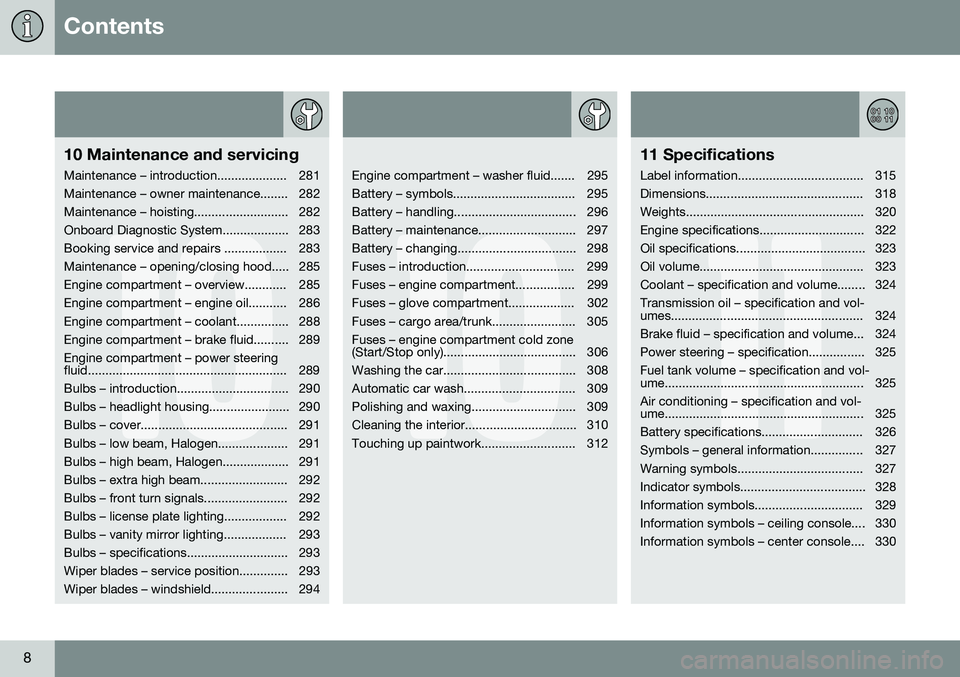
Contents
8
10
10 Maintenance and servicing
Maintenance – introduction.................... 281
Maintenance – owner maintenance........ 282
Maintenance – hoisting........................... 282
Onboard Diagnostic System................... 283
Booking service and repairs .................. 283
Maintenance – opening/closing hood..... 285
Engine compartment – overview............ 285
Engine compartment – engine oil........... 286
Engine compartment – coolant............... 288
Engine compartment – brake fluid.......... 289Engine compartment – power steering
fluid......................................................... 289
Bulbs – introduction................................ 290
Bulbs – headlight housing....................... 290
Bulbs – cover.......................................... 291
Bulbs – low beam, Halogen.................... 291
Bulbs – high beam, Halogen................... 291
Bulbs – extra high beam......................... 292
Bulbs – front turn signals........................ 292
Bulbs – license plate lighting.................. 292
Bulbs – vanity mirror lighting.................. 293
Bulbs – specifications............................. 293
Wiper blades – service position.............. 293
Wiper blades – windshield...................... 294
10
Engine compartment – washer fluid....... 295
Battery – symbols................................... 295
Battery – handling................................... 296
Battery – maintenance............................ 297
Battery – changing.................................. 298
Fuses – introduction............................... 299
Fuses – engine compartment................. 299
Fuses – glove compartment................... 302
Fuses – cargo area/trunk........................ 305Fuses – engine compartment cold zone
(Start/Stop only)...................................... 306
Washing the car...................................... 308
Automatic car wash................................ 309
Polishing and waxing.............................. 309
Cleaning the interior................................ 310
Touching up paintwork........................... 312
11
11 Specifications
Label information.................................... 315
Dimensions............................................. 318
Weights................................................... 320
Engine specifications.............................. 322
Oil specifications..................................... 323
Oil volume............................................... 323
Coolant – specification and volume........ 324Transmission oil – specification and vol-
umes....................................................... 324
Brake fluid – specification and volume... 324
Power steering – specification................ 325Fuel tank volume – specification and vol-
ume......................................................... 325 Air conditioning – specification and vol-
ume......................................................... 325
Battery specifications............................. 326
Symbols – general information............... 327
Warning symbols.................................... 327
Indicator symbols.................................... 328
Information symbols............................... 329
Information symbols – ceiling console.... 330
Information symbols – center console.... 330
Page 239 of 344
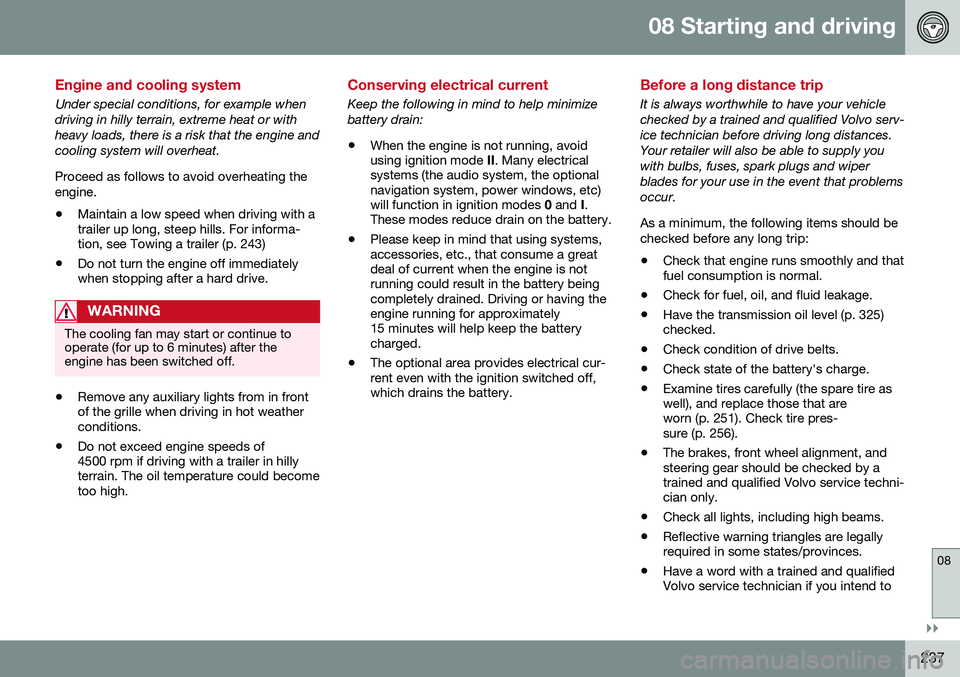
08 Starting and driving
08
}}
237
Engine and cooling system
Under special conditions, for example when driving in hilly terrain, extreme heat or withheavy loads, there is a risk that the engine andcooling system will overheat. Proceed as follows to avoid overheating the engine. •Maintain a low speed when driving with a trailer up long, steep hills. For informa-tion, see Towing a trailer (p. 243)
• Do not turn the engine off immediatelywhen stopping after a hard drive.
WARNING
The cooling fan may start or continue to operate (for up to 6 minutes) after theengine has been switched off.
•
Remove any auxiliary lights from in front of the grille when driving in hot weatherconditions.
• Do not exceed engine speeds of4500 rpm if driving with a trailer in hillyterrain. The oil temperature could becometoo high.
Conserving electrical current
Keep the following in mind to help minimize battery drain:
• When the engine is not running, avoid using ignition mode
II. Many electrical
systems (the audio system, the optionalnavigation system, power windows, etc)will function in ignition modes 0 and I.
These modes reduce drain on the battery.
• Please keep in mind that using systems,accessories, etc., that consume a greatdeal of current when the engine is notrunning could result in the battery beingcompletely drained. Driving or having theengine running for approximately15 minutes will help keep the batterycharged.
• The optional area provides electrical cur-rent even with the ignition switched off,which drains the battery.
Before a long distance trip
It is always worthwhile to have your vehicle checked by a trained and qualified Volvo serv-ice technician before driving long distances.Your retailer will also be able to supply youwith bulbs, fuses, spark plugs and wiperblades for your use in the event that problemsoccur. As a minimum, the following items should be checked before any long trip:
• Check that engine runs smoothly and that fuel consumption is normal.
• Check for fuel, oil, and fluid leakage.
• Have the transmission oil level (p. 325)checked.
• Check condition of drive belts.
• Check state of the battery's charge.
• Examine tires carefully (the spare tire aswell), and replace those that areworn (p. 251). Check tire pres-sure (p. 256).
• The brakes, front wheel alignment, andsteering gear should be checked by atrained and qualified Volvo service techni-cian only.
• Check all lights, including high beams.
• Reflective warning triangles are legallyrequired in some states/provinces.
• Have a word with a trained and qualifiedVolvo service technician if you intend to
Page 301 of 344
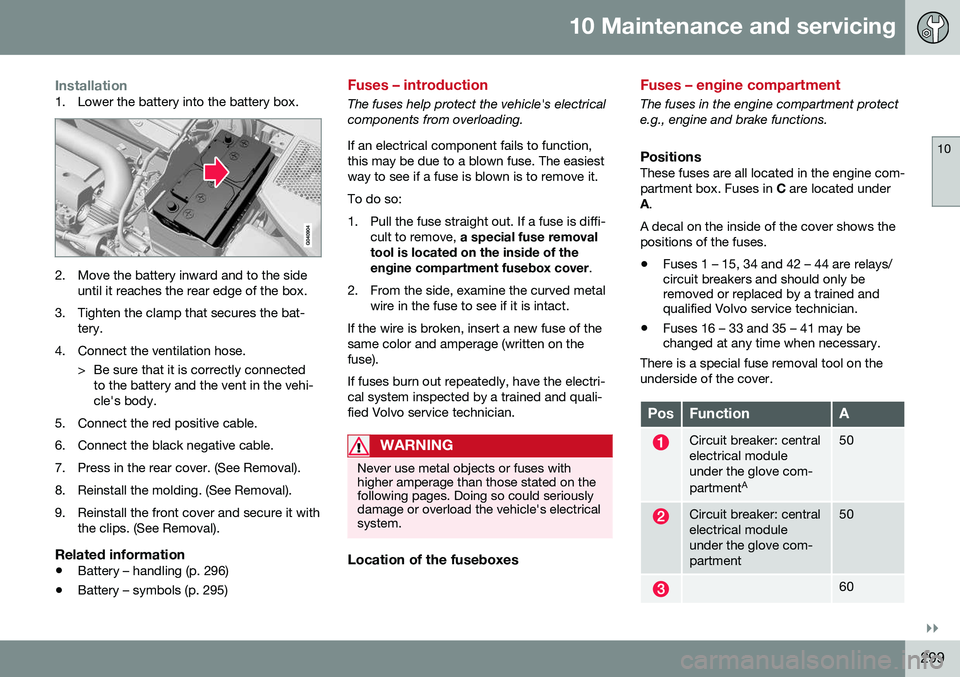
10 Maintenance and servicing
10
}}
299
Installation1. Lower the battery into the battery box.
2. Move the battery inward and to the sideuntil it reaches the rear edge of the box.
3. Tighten the clamp that secures the bat- tery.
4. Connect the ventilation hose. > Be sure that it is correctly connectedto the battery and the vent in the vehi- cle's body.
5. Connect the red positive cable.
6. Connect the black negative cable.
7. Press in the rear cover. (See Removal).
8. Reinstall the molding. (See Removal).
9. Reinstall the front cover and secure it with the clips. (See Removal).
Related information
• Battery – handling (p. 296)
• Battery – symbols (p. 295)
Fuses – introduction
The fuses help protect the vehicle's electrical components from overloading. If an electrical component fails to function, this may be due to a blown fuse. The easiestway to see if a fuse is blown is to remove it. To do so:
1. Pull the fuse straight out. If a fuse is diffi-
cult to remove, a special fuse removal
tool is located on the inside of the engine compartment fusebox cover .
2. From the side, examine the curved metal wire in the fuse to see if it is intact.
If the wire is broken, insert a new fuse of the same color and amperage (written on thefuse). If fuses burn out repeatedly, have the electri- cal system inspected by a trained and quali-fied Volvo service technician.
WARNING
Never use metal objects or fuses with higher amperage than those stated on thefollowing pages. Doing so could seriouslydamage or overload the vehicle's electricalsystem.
Location of the fuseboxes
Fuses – engine compartment
The fuses in the engine compartment protect e.g., engine and brake functions.
PositionsThese fuses are all located in the engine com-partment box. Fuses in C are located under
A .
A decal on the inside of the cover shows thepositions of the fuses. • Fuses 1 – 15, 34 and 42 – 44 are relays/ circuit breakers and should only beremoved or replaced by a trained andqualified Volvo service technician.
• Fuses 16 – 33 and 35 – 41 may bechanged at any time when necessary.
There is a special fuse removal tool on the underside of the cover.
PosFunctionA
Circuit breaker: central electrical moduleunder the glove com- partment A50
Circuit breaker: central electrical moduleunder the glove com-partment50
60
Page 303 of 344
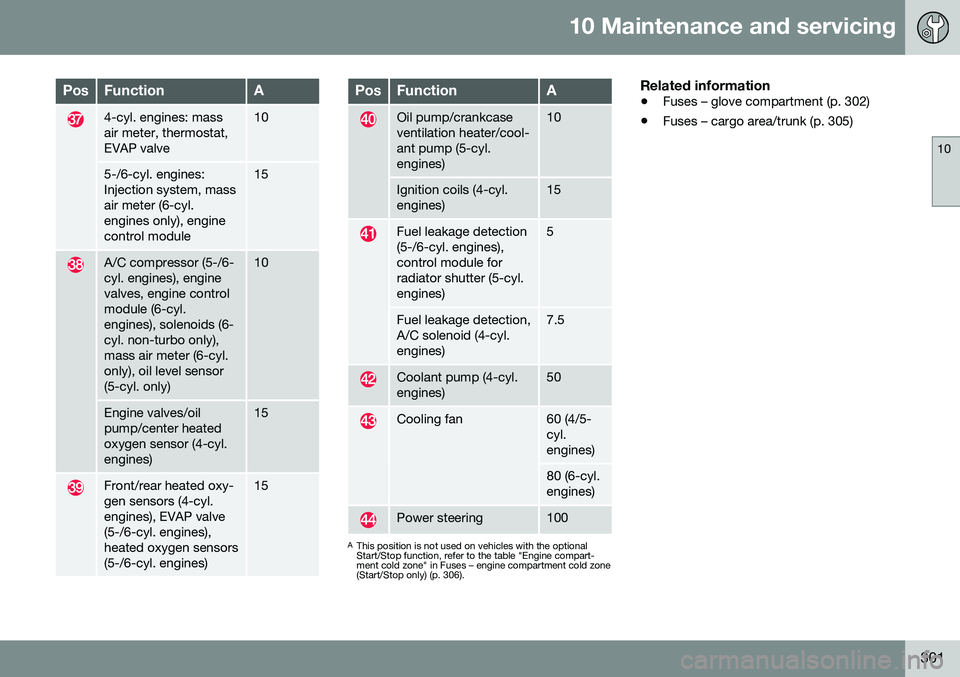
10 Maintenance and servicing
10
301
PosFunctionA
4-cyl. engines: mass air meter, thermostat,EVAP valve10
5-/6-cyl. engines: Injection system, massair meter (6-cyl.engines only), enginecontrol module15
A/C compressor (5-/6- cyl. engines), enginevalves, engine controlmodule (6-cyl.engines), solenoids (6-cyl. non-turbo only),mass air meter (6-cyl.only), oil level sensor(5-cyl. only)10
Engine valves/oil pump/center heatedoxygen sensor (4-cyl.engines)15
Front/rear heated oxy- gen sensors (4-cyl.engines), EVAP valve(5-/6-cyl. engines),heated oxygen sensors(5-/6-cyl. engines)15
PosFunctionA
Oil pump/crankcase ventilation heater/cool-ant pump (5-cyl.engines)10
Ignition coils (4-cyl. engines)15
Fuel leakage detection (5-/6-cyl. engines),control module forradiator shutter (5-cyl.engines)5
Fuel leakage detection, A/C solenoid (4-cyl.engines)7.5
Coolant pump (4-cyl. engines)50
Cooling fan60 (4/5- cyl.engines)
80 (6-cyl. engines)
Power steering100
AThis position is not used on vehicles with the optional Start/Stop function, refer to the table "Engine compart-ment cold zone" in Fuses – engine compartment cold zone(Start/Stop only) (p. 306).
Related information
• Fuses – glove compartment (p. 302)
• Fuses – cargo area/trunk (p. 305)
Page 304 of 344
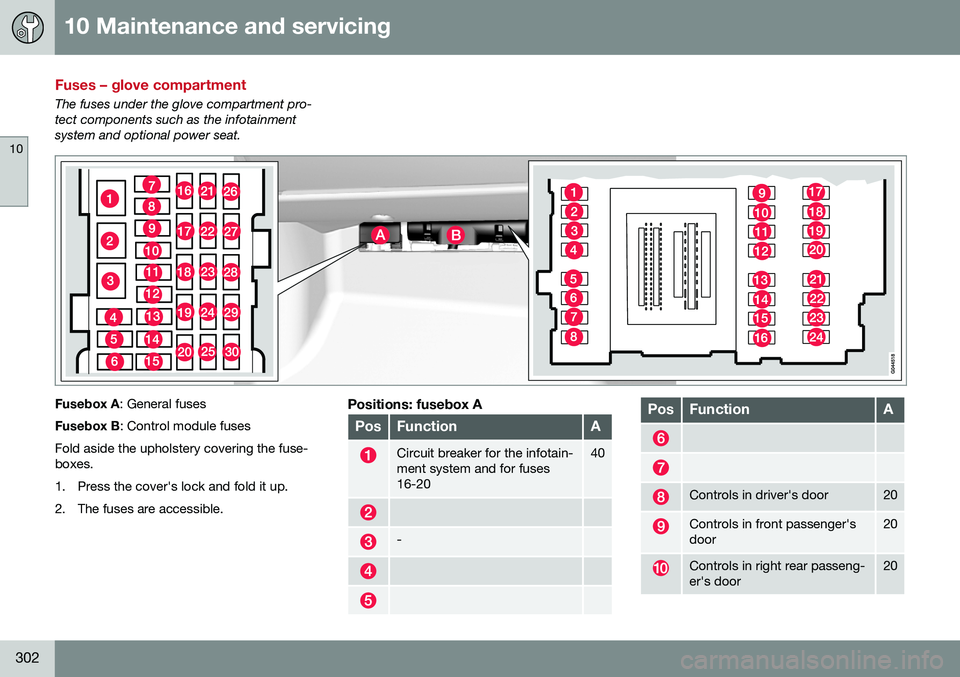
10 Maintenance and servicing
10
302
Fuses – glove compartment
The fuses under the glove compartment pro- tect components such as the infotainmentsystem and optional power seat.
Fusebox A: General fuses
Fusebox B : Control module fuses
Fold aside the upholstery covering the fuse- boxes.
1. Press the cover's lock and fold it up.
2. The fuses are accessible.Positions: fusebox A
PosFunctionA
Circuit breaker for the infotain- ment system and for fuses16-2040
-
PosFunctionA
Controls in driver's door20
Controls in front passenger's door20
Controls in right rear passeng- er's door20
Page 306 of 344
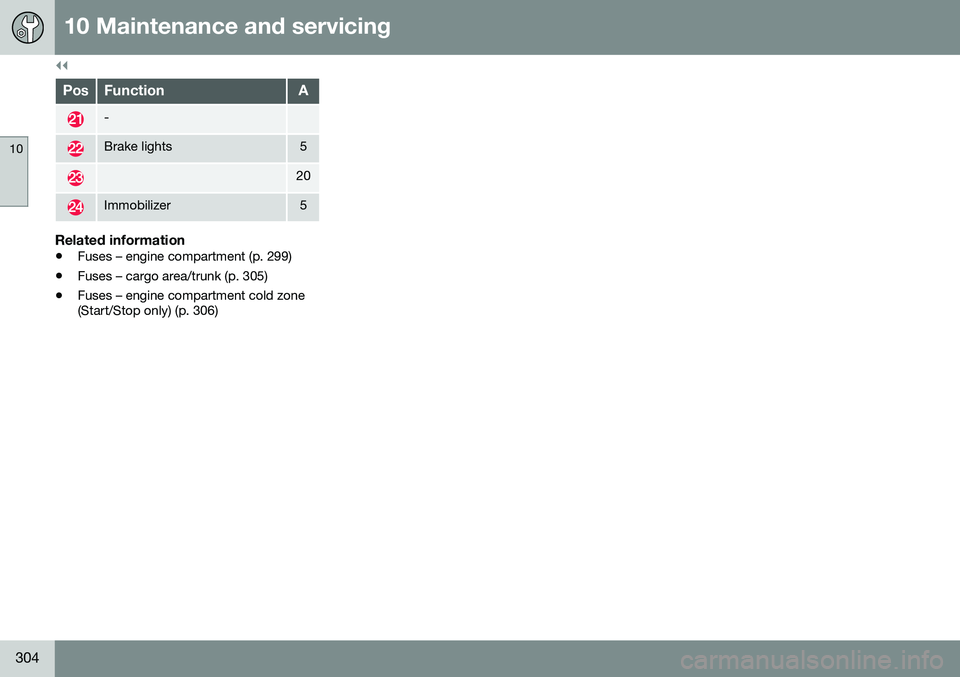
||
10 Maintenance and servicing
10
304
PosFunctionA
-
Brake lights5
20
Immobilizer5
Related information
•Fuses – engine compartment (p. 299)
• Fuses – cargo area/trunk (p. 305)
• Fuses – engine compartment cold zone (Start/Stop only) (p. 306)
Page 307 of 344
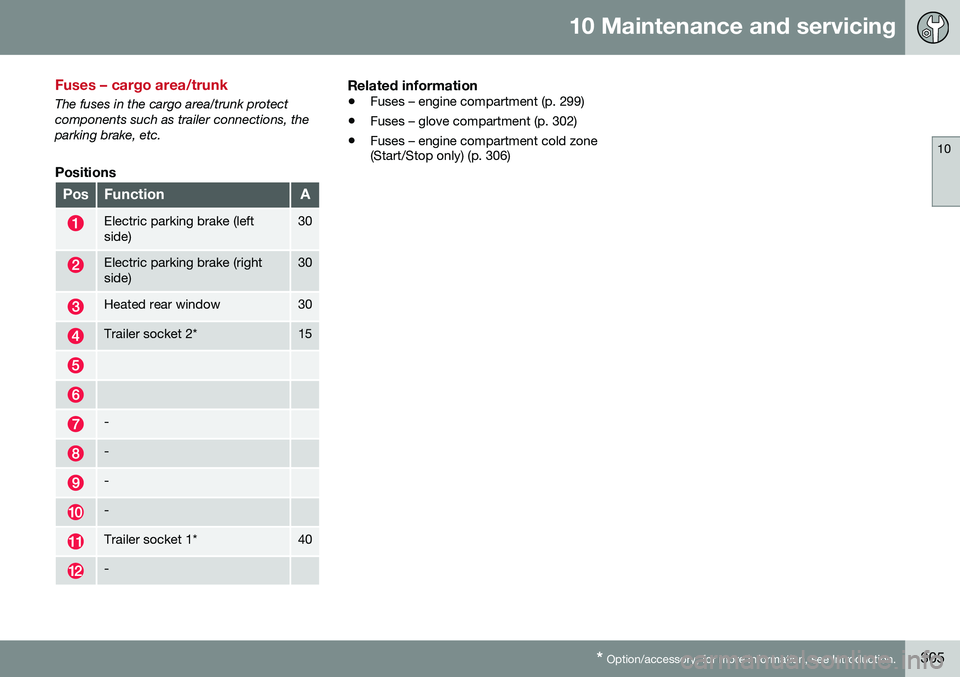
10 Maintenance and servicing
10
* Option/accessory, for more information, see Introduction.305
Fuses – cargo area/trunk
The fuses in the cargo area/trunk protect components such as trailer connections, theparking brake, etc.
Positions
PosFunctionA
Electric parking brake (left side)30
Electric parking brake (right side)30
Heated rear window30
Trailer socket 2*15
-
-
-
-
Trailer socket 1*40
-
Related information
• Fuses – engine compartment (p. 299)
• Fuses – glove compartment (p. 302)
• Fuses – engine compartment cold zone (Start/Stop only) (p. 306)
Page 308 of 344
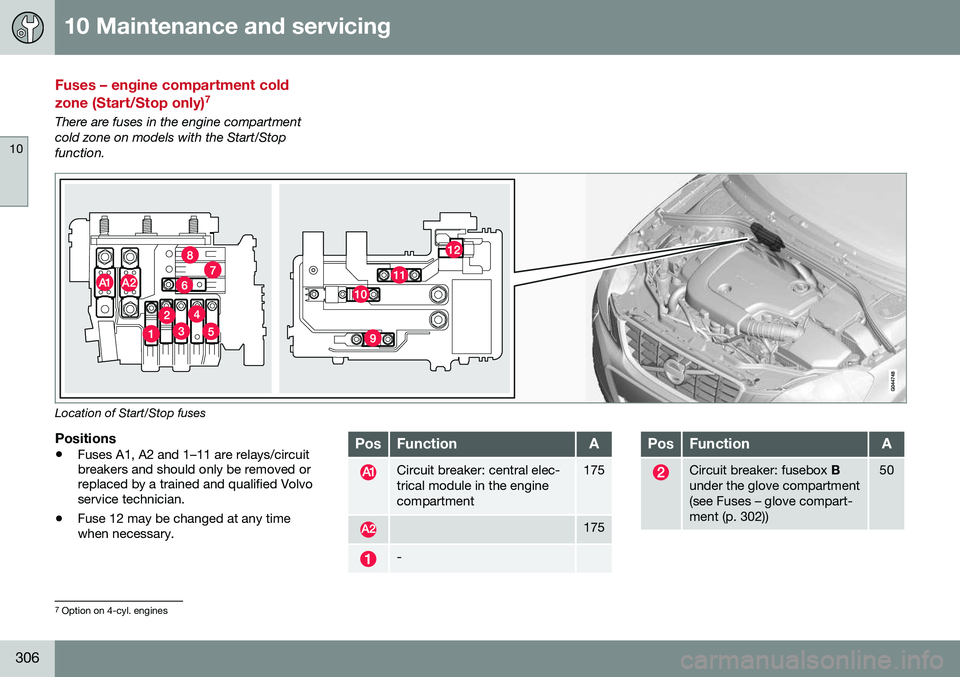
10 Maintenance and servicing
10
306
Fuses – engine compartment cold zone (Start/Stop only)7
There are fuses in the engine compartment cold zone on models with the Start/Stopfunction.
Location of Start/Stop fuses
Positions
•
Fuses A1, A2 and 1–11 are relays/circuit breakers and should only be removed orreplaced by a trained and qualified Volvoservice technician.
• Fuse 12 may be changed at any timewhen necessary.PosFunctionA
Circuit breaker: central elec- trical module in the enginecompartment175
175
-
PosFunctionA
Circuit breaker: fusebox
B
under the glove compartment (see Fuses – glove compart-ment (p. 302))50
7 Option on 4-cyl. engines
Page 309 of 344
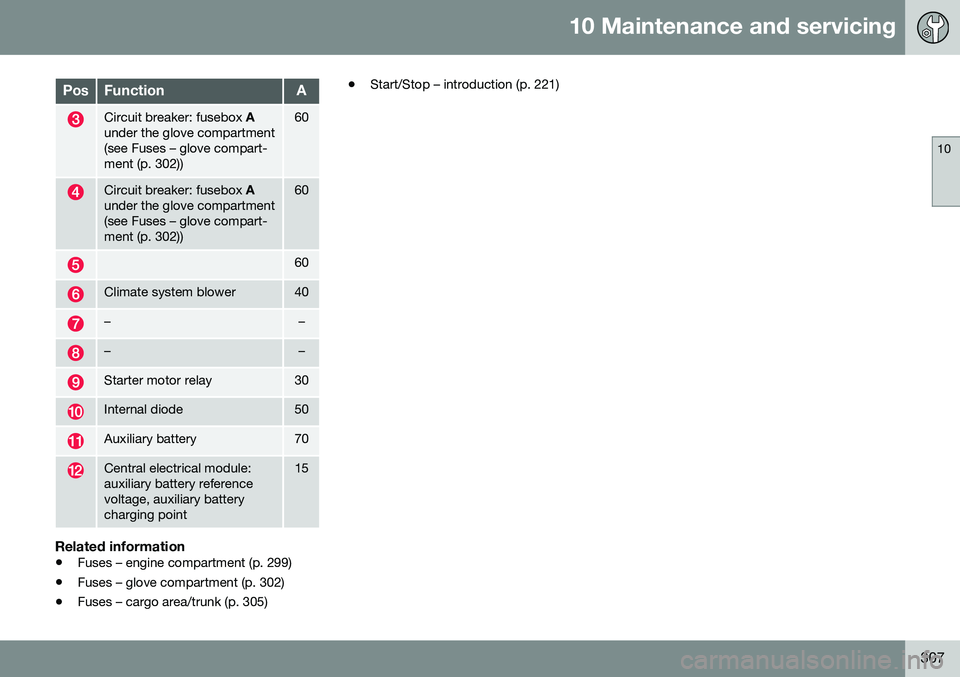
10 Maintenance and servicing
10
307
PosFunctionA
Circuit breaker: fusebox A
under the glove compartment (see Fuses – glove compart-ment (p. 302))60
Circuit breaker: fusebox A
under the glove compartment (see Fuses – glove compart-ment (p. 302))60
60
Climate system blower40
––
––
Starter motor relay30
Internal diode50
Auxiliary battery70
Central electrical module: auxiliary battery referencevoltage, auxiliary batterycharging point15
Related information
• Fuses – engine compartment (p. 299)
• Fuses – glove compartment (p. 302)
• Fuses – cargo area/trunk (p. 305) •
Start/Stop – introduction (p. 221)
Page 336 of 344
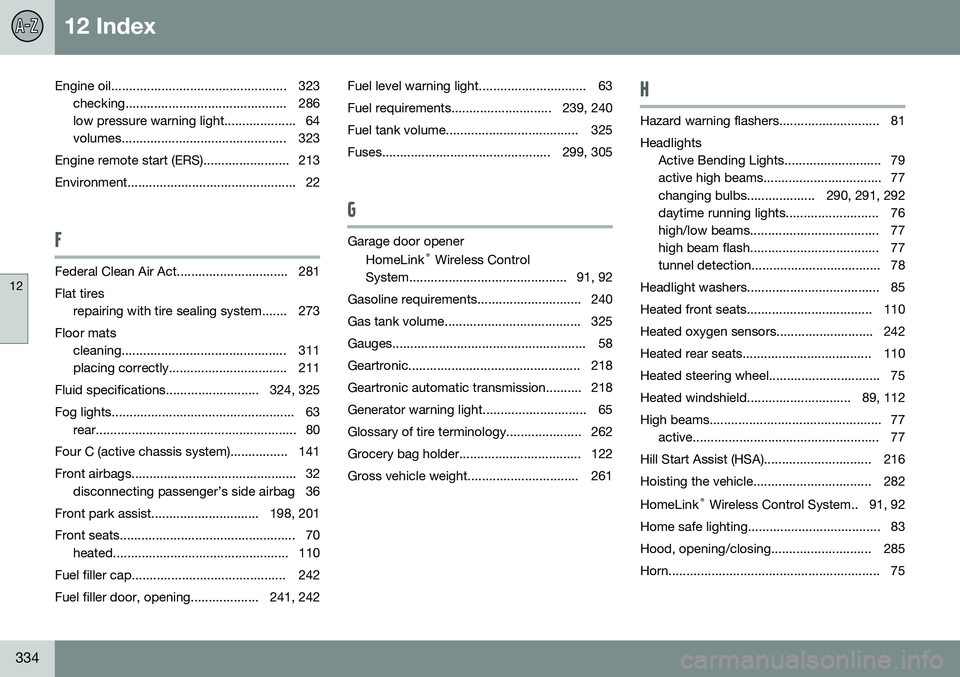
12 Index
12
334
Engine oil................................................. 323checking............................................. 286
low pressure warning light.................... 64
volumes.............................................. 323
Engine remote start (ERS)........................ 213
Environment............................................... 22
F
Federal Clean Air Act............................... 281 Flat tires repairing with tire sealing system....... 273
Floor mats cleaning.............................................. 311
placing correctly................................. 211
Fluid specifications.......................... 324, 325
Fog lights................................................... 63 rear........................................................ 80
Four C (active chassis system)................ 141
Front airbags.............................................. 32 disconnecting passenger’s side airbag 36
Front park assist.............................. 198, 201
Front seats................................................. 70 heated................................................. 110
Fuel filler cap........................................... 242
Fuel filler door, opening................... 241, 242 Fuel level warning light.............................. 63
Fuel requirements............................ 239, 240
Fuel tank volume..................................... 325
Fuses............................................... 299, 305
G
Garage door opener
HomeLink ®
Wireless Control
System............................................ 91, 92
Gasoline requirements............................. 240
Gas tank volume...................................... 325
Gauges...................................................... 58
Geartronic................................................ 218
Geartronic automatic transmission.......... 218
Generator warning light............................. 65
Glossary of tire terminology..................... 262
Grocery bag holder.................................. 122
Gross vehicle weight............................... 261
H
Hazard warning flashers............................ 81 Headlights Active Bending Lights........................... 79
active high beams................................. 77
changing bulbs................... 290, 291, 292
daytime running lights.......................... 76
high/low beams.................................... 77
high beam flash.................................... 77
tunnel detection.................................... 78
Headlight washers..................................... 85
Heated front seats................................... 110
Heated oxygen sensors........................... 242
Heated rear seats.................................... 110
Heated steering wheel............................... 75
Heated windshield............................. 89, 112
High beams................................................ 77 active.................................................... 77
Hill Start Assist (HSA).............................. 216
Hoisting the vehicle................................. 282 HomeLink ®
Wireless Control System.. 91, 92
Home safe lighting..................................... 83
Hood, opening/closing............................ 285
Horn........................................................... 75